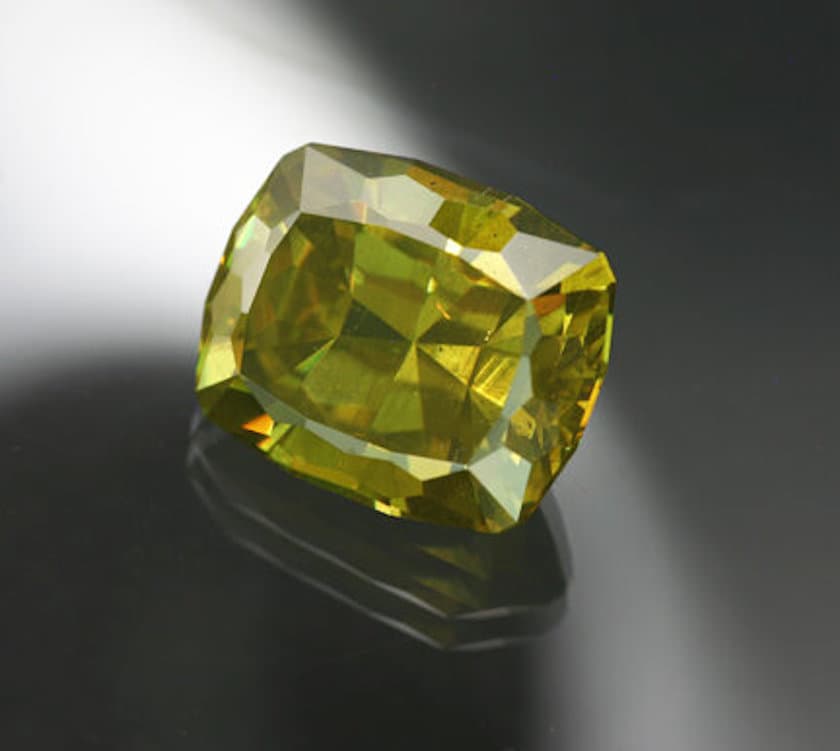Sphalerite Value, Price, and Jewelry Information
Sphalerite occurs in many colors. With a dispersion over three times that of diamond and an adamantine luster, faceted specimens make beautiful additions to gem collections. However, they're too soft for most jewelry uses.
2 Minute Read
Sphalerite occurs in many colors, including green, yellow, orange, brown, and fiery red. With a dispersion over three times that of diamond and an adamantine luster, faceted specimens make beautiful additions to gem collections. However, they’re too soft for most jewelry uses.
Start an IGS Membership today
for full access to our price guide (updated monthly).Sphalerite Value
Comments
You'll find no shortage of facetable sphalerite rough in most colors. Faceting this material, however, poses a challenge. Sphalerites have a low hardness (3.5 to 4) and perfect cleavage.
Iron-rich, opaque, black stones are known as marmatites, named after the locality, Marmato, Italy. In Europe, sphalerite is sometimes called blende, after the German word blenden, "to dazzle." Though they have no connection to actual ruby gems, stones with red and orange shades are sometimes called "ruby blende." Low-iron, pale and colorless sphalerites, known as cleiophanes, are extremely rare.
A number of trace elements may contribute to color in sphalerites. These include germanium, calcium, copper, mercury, and cerium (yellow); tin, silver, and molybdenum (reddish); and cobalt and iron (green).
Sphalerite and wurtzite are polymorphs. They share the same chemical formula (ZnS), but have different crystal habits. Sphalerite has an isometric crystal structure, while wurtzite has a hexagonal structure. These two minerals can coexist in alternating layers as schalenblende, a gem material used rarely for cabochons.
Identifying Characteristics
Sphalerites may have a streak color ranging from pale brown to yellow or white. Keep in mind that streak testing can destroy the test sample. Conduct this examination only as a last resort for gem identification on rough, never on a finished gem. This test will also release a sulfurous odor from the test sample.
Sphalerites are pyroelectric. When heated, these gems generate an electrical charge.
Sphalerites may show anomalous double refraction due to crystal strain.
Synthetics
Since sphalerite ranks as the primary ore for zinc mining, scientists have synthesized this mineral for industrial research. In addition, facetable synthetic sphalerites in all their colors have appeared in jewelry and gem collections.
Enhancements
No known gemstone treatments.
Polishing scratches on the bottoms of sphalerite cabochons may cause apparent chatoyancy and asterism. (Although these scratches may occur accidentally, be aware that sphalerites don't normally display these phenomenal effects).
Sources
Significant gem-quality sources include the following:
- Santander, Spain: major gem locality, large cleavages of red-orange color.
- Cananea, Sonora, Mexico: fine green transparent material, often pale colored and color zoned, sometimes yellow.
- Kipushi, Democratic Republic of the Congo: dark green material containing elevated amounts of cobalt and iron.
- United States: Franklin, New Jersey (almost colorless to pale green, transparent variety known as cleiophane); Kansas/Missouri/Oklahoma (so-called Tri-State Region, heavily mineralized by lead and zinc, with many localities and operating mines); Tiffin, Ohio (red color); Colorado/Utah (may be transparent); Arizona; Idaho; Montana; Wisconsin.
- Australia; Canada; China; Czech Republic; England; France; Germany; Tsumeb, Namibia; Romania; Scotland; Sweden
Stone Sizes
From the large, reddish material from Spain, faceters could easily cut gems of hundreds of carats, as well as cabochons. Green cleiophane material from New Jersey has yielded faceted gems as large as 15 carats. Mexican material could yield faceted gems to 50 carats.
- Smithsonian Institution (Washington, DC): 73.3, 68.9 (yellow-brown. Utah); 59.5 (yellow-green, New Jersey): 48 (yellow, Mexico); 61.9, 45.9 (yellow, Spain).
- California Academy of Sciences (San Francisco): 150.3 (dark red-brown oval, Spain).
- National Museums of Canada (Ottawa, Ontario): 100.1 (dark orange, round, Spain).
- Private Collection: 24.8 (gray-green, Mt. Ste. Hilaire, Quebec).
Care
Clean sphalerites only with a soft brush, mild detergent, and warm water. See our Gemstone Jewelry Cleaning Guide for more recommendations.
Joel E. Arem, Ph.D., FGA
Dr. Joel E. Arem has more than 60 years of experience in the world of gems and minerals. After obtaining his Ph.D. in Mineralogy from Harvard University, he has published numerous books that are still among the most widely used references and guidebooks on crystals, gems and minerals in the world.
Co-founder and President of numerous organizations, Dr. Arem has enjoyed a lifelong career in mineralogy and gemology. He has been a Smithsonian scientist and Curator, a consultant to many well-known companies and institutions, and a prolific author and speaker. Although his main activities have been as a gem cutter and dealer, his focus has always been education.
Barbara Smigel, PhD. GG
Barbara Smigel is a GIA certified gemologist, facetor, jewelry designer, gem dealer, gemology instructor and creator of the well-regarded educational websites acstones.com and bwsmigel.info.
International Gem Society
Related Articles
Sphalerite Buying Guide
Sphalerite Appraisal
Jadeite Value, Price, and Jewelry Information
Brookite Value, Price, and Jewelry Information
Never Stop Learning
When you join the IGS community, you get trusted diamond & gemstone information when you need it.
Get Gemology Insights
Get started with the International Gem Society’s free guide to gemstone identification. Join our weekly newsletter & get a free copy of the Gem ID Checklist!
